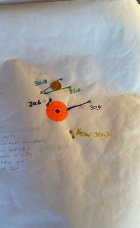How many times does a "flat spot" have to occur in the same spot for it to be relevant?
How many shots are required to achieve confidence in the observation depends upon the variability of the data set and the precision required of the observation.
On Page 2, I shared confidence assessment of your velocity data, even over your 20 shot strings, your average your shotmarker velocity displayed was only accurate within 6-7fps of the true average, with a 95% confidence interval. Granted, I expect the 13-14fps SD’s the Shotmarker picked up would not represent the true SD’s of your MV’s on those strings, but with high variability like that, it takes more shots to establish confidence - for that batch of ammo, it would take more than 20 shots, based on your data provided. So as I described on the previous pages, your data showed ~13-14fps SD, so we’re really only ~34% sure that any velocity on that page is within 13-14fps of its true value (what an average of an infinite population of shots of the same charge would be). That’s not necessarily a problem until we start doing an assessment of flat spots which need the shot to be accurate to within a window of 3-4fps to look like a flat spot instead of higher or lower and look like a ramp.
This is why I’m describing that trying to prove flat spots exist is futile - it WOULD take enough ammo to burn barrels, but all along the way, the data is pointing to the fact flat spots do NOT exist. It’s easier to just accept that and shoot less rounds and promote fruitful loads without worrying about velocity flat spots.
Can't the same logic be applied to the point of impact as well?
Yes, unfortunately. But there’s already enough push back against the negative assessment done for the validity of the Satterlee/Audette velocity curve, nobody really wants the blowback from doing the same for the Audette POI Ladder. In that discussion, using mean radius from centroid, or normalization data for group size is critical, so we can determine a heat map of where a population of bullets for a given charge would land - represented by 1-3 actual bullets. Guys see that all of the time - a POI ladder puts 3 shots of 3-4 charges within 1/4moa of one another, so then we run with that, and sometimes “loads fall apart” and a guy starting with a couple 2-3” groups at Nat’s ends up finishing with a couple 4-6” groups and blows his agg. Same load, nothing changed, just the Fates delivering statistically probable outcomes in a coincidental order.
This also points towards a differentiation of inductive vs deductive experimentation. Folks think they are doing a deductive experiment, but in the end, shooting small groups at distance is shooting small groups at distance, so no matter what they pick and why, it ends up shooting small because it shoots small. But yes, many folks expect that if we run the same assessment of whether POI ladders work for the reasons folks believe or not, we’ll see the same outcome - but evidence shows that well built rifles shoot small, and shooting a load enough to get to know how it shoots gives shooters enough info to shoot small. Inductive experimental outcomes are still successful, even if they aren’t deductive.












